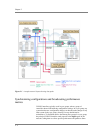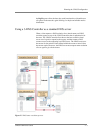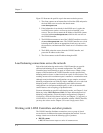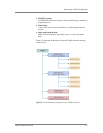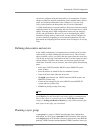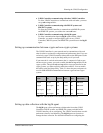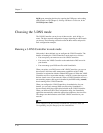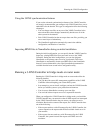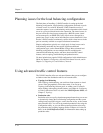
Chapter 2
2 - 8
group receive broadcasts of metrics data from the big3d agents. All
members of the sync group also receive broadcasts of updated configuration
settings from the 3-DNS Controller that has the latest configuration changes.
When you define the sync group, you select the sync group members from
the list of 3-DNS Controllers you have already defined. The sync group lists
the 3-DNS Controllers in the order in which you selected them. The first
3-DNS Controller in the list becomes the principal 3-DNS Controller. The
remaining 3-DNS Controllers in the list become receivers. If the principal
3-DNS Controller becomes disabled, the next 3-DNS Controller in the list
becomes the principal 3-DNS Controller until the original principal 3-DNS
Controller comes back online.
Understanding how a sync group works
The sync group feature synchronizes individual configuration files, such as
wideip.conf, and other files that store system settings. You have the option
of adding files to the synchronization list.
The 3-DNS Controllers in a sync group operate as peer servers. At set
intervals, the syncd utility compares the time stamps of the configuration
files earmarked for synchronization on all of the 3-DNS Controllers. If the
time stamp on a specific file differs between 3-DNS Controllers, the 3-DNS
Controller with the latest file broadcasts the file to all of the other 3-DNS
Controllers in the group.
Understanding how the time tolerance variable affects a sync group
The time tolerance variable is a global variable that defines the number of
seconds that the time setting on one 3-DNS Controller can be ahead or
behind the time setting on another 3-DNS Controller. If the difference
between the times on the systems is greater than the time tolerance, the time
setting on the 3-DNS Controller running behind is reset to match the 3-DNS
Controller with the most recent time. For example, if the time tolerance is 5
seconds, and one 3-DNS Controller is running 10 seconds ahead of the
other, the 3-DNS Controller running behind has its time reset to match the
one running 10 seconds ahead. If the second system was running only 2
seconds ahead of the other, the time settings would remain unchanged. The
values are 0, 5, and higher (values of 1-4 are automatically set to 5, and 0
turns off time synchronization). The default setting is 10 seconds.
The time setting on 3-DNS Controllers is important because a 3-DNS
Controller compares time stamps on files when deciding whether to
synchronize files with other 3-DNS Controllers in the sync group.
Setting up communications on a 3-DNS Controller
There are three different communication issues that you need to resolve
when you set up communication between the 3-DNS Controllers running in
your network.





